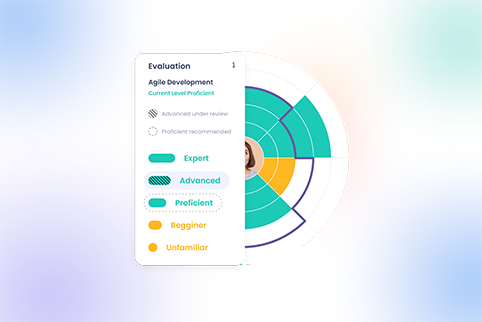Rethinking Talent Acquisition with Talent Matching
11 min read

Are you ready to revolutionize the way you build your dream team? Welcome aboard the journey of talent matching – a dynamic process where skills, aspirations, and opportunities intertwine to create the perfect synergy within your organization. Think of talent matching as the ultimate puzzle-solving adventure, where each piece represents a unique skill set, experience, and career goal, intricately fitting into the bigger picture of organizational success.
In the swiftly evolving corporate environment of today, traditional hiring methods often fall short in meeting the dynamic needs of organizations. But what sets talent matching apart from conventional hiring practices? It’s the emphasis on understanding each employee’s unique strengths, experiences, and career aspirations, and leveraging this insight to create tailored opportunities for growth and development.
In this article, we’ve unpacked the principles, benefits and strategies for talent matching, shedding light on how organizations can harness its power to drive performance, foster innovation, and stay ahead in a competitive market.
What is talent matching?
At its heart, talent matching is like playing matchmaker in the professional world. It’s about connecting the dots between individuals’ skills, experiences, and career aspirations with the right opportunities within an organization.
Gone are the days of one-size-fits-all job descriptions and generic resumes. Talent matching takes a more nuanced approach, focusing on individual competencies, experiences, and potential. Essentially, it’s about finding the right person for the right job at the right time.
Traditional recruitment methods often focus solely on external hires, overlooking the wealth of talent already present within the organization. Talent matching, however, takes a holistic approach. It involves tapping into the existing talent pool, understanding each employee’s strengths and aspirations, and strategically deploying them where they can make the most impact.
Imagine a scenario where a project requires a blend of technical expertise, creativity, and leadership skills. Instead of immediately looking outside the organization for candidates, talent matching allows HR executives and managers to identify individuals within the company who possess the required skills or have the potential to develop them. By leveraging internal talent, organizations can foster a culture of growth and development while also optimizing resource utilization and reducing hiring costs.
But talent matching isn’t just about filling immediate needs. It’s also about proactively planning for the future. By continuously assessing the skills and aspirations of employees, organizations can identify potential gaps and opportunities for upskilling or reskilling. This proactive approach not only ensures that the organization remains agile and competitive in a rapidly evolving market but also boosts employee engagement and retention by demonstrating a commitment to their growth and development.
What is the mechanism behind it and how do skills come into play?
The rise of skills-based approaches in talent management has transformed the way organizations assess and match talent. Instead of relying solely on job titles or qualifications, skills-based matching focuses on individuals’ competencies and capabilities, allowing for more accurate and personalized talent placements. This shift from a static, role-centric mindset to a dynamic, skills-centric approach enables organizations to adapt swiftly to changing business needs and market demands.
Skills play a pivotal role in talent matching, serving as the cornerstone for identifying the right fit between individuals and opportunities within an organization. Here’s how skills contribute to the talent matching process:
Spotting the Right Skills: Talent matching hinges on a clear understanding of the skills needed for a particular role or project. This starts with identifying the specific skills required—be it technical know-how, soft skills, or industry-specific knowledge. These skills act as the blueprint for finding the perfect fit for the job.
In fact, according to LinkedIn, 73% of recruiting professionals prioritize hiring based on skills within their organizations. This focus on skills is not without merit. The same data suggests that focusing on skills can expand talent pools by up to 10 times, emphasizing the importance of skill-based recruitment strategies.
Aligning Skills with Opportunities: Talent matching is all about connecting people’s skills with the needs of specific roles or projects. This process begins with a thorough analysis of the skill profiles of employees, which includes assessing their strengths, experiences, and areas for development. HR executives and managers should also examine the skill demands associated with different positions or projects within the company.
By comparing these two sets of data, HR professionals can identify potential matches between individuals and roles where their skills are best suited. This matching process goes beyond merely filling positions; it aims to ensure that individuals are placed in roles where they can thrive and make meaningful contributions.
Gap Analysis and Upskilling: Talent matching, particularly through skills mapping, serves as the foundation for conducting comprehensive gap analyses within organizations. By systematically comparing the skill profiles of employees with the skill requirements of various roles or projects, HR teams can pinpoint areas where there may be a shortage of specific skills. This gap analysis provides valuable insights into the skill deficiencies within the workforce, highlighting areas that require immediate attention.
Armed with this insight, HR teams can then design and implement targeted upskilling or reskilling initiatives aimed at bridging the identified gaps. These initiatives may take various forms, such as training programs, workshops, or online courses, tailored to address the specific skill needs of employees.
Promotion of Diversity and Inclusion: By considering a diverse range of skills and experiences, talent matching contributes to fostering diversity and inclusion within the organization. It ensures that opportunities are accessible to individuals from different backgrounds and with varied skill sets, expanding the talent pool and fostering innovation.
Continuous Skill Development: Talent matching isn’t a one-and-done deal; it’s an ongoing journey. As organizations grow and tech advances, skill requirements shift. This calls for ongoing monitoring and adjustment in talent matching. Today’s competitive market demands more than just matching skills to roles; it’s about foreseeing future needs and preparing for them in advance. It involves staying updated on skill trends and investing in tomorrow’s skills to maintain a competitive edge.
How does AI contribute to talent matching?
Artificial Intelligence (AI) is transforming the way we match talent, offering powerful tools to make the process more efficient and effective. At its core, AI enhances talent matching by using advanced algorithms and data analytics to identify, assess, and connect individuals with the right opportunities within an organization.
76% of HR leaders believe that if their organization does not adopt and implement AI solutions, such as generative AI, in the next 12 to 24 months, they will be lagging in organizational success compared to those that do.
AI’s role in talent matching is multifaceted, starting with data analysis. AI-powered systems can sift through large datasets, including resumes, job descriptions, performance reviews, and skills assessments, to spot patterns and connections that human recruiters might miss. This analysis helps AI build detailed profiles of candidates and positions, leading to more precise matches based on skills, experiences, and cultural fit.
AI also plays a crucial role in candidate sourcing and screening. Automated systems can scan online platforms, social media networks, and internal databases to identify potential candidates who possess the desired skills and qualifications. Through natural language processing (NLP) and machine learning, AI can evaluate resumes, cover letters, and other documents to assess candidates’ suitability for particular roles, saving recruiters time and effort.
With the backing of statistics like those from Tidio, showing that about 79% of recruiters foresee AI becoming sophisticated enough to autonomously make hiring and firing decisions, while about 68% of them think that using AI in recruitment will help eliminate unintentional bias, it’s evident that AI is not just a trend but a crucial tool shaping the future of recruitment.
Moreover, AI-driven predictive analytics can also predict future talent needs based on past data and market trends. By analyzing factors such as employee turnover rates, industry shifts, and emerging skill requirements, AI can help organizations anticipate staffing needs and proactively develop strategies to address them.
Beyond just speeding up the matching process, AI also enhances candidate engagement and experience. AI-powered chatbots can interact with candidates in real-time, answering queries, offering feedback, and guiding them through applications. This personalized touch not only improves the candidate journey but also allows recruiters to focus on building relationships with top talent.
What are the benefits of talent matching?
The benefits of talent matching are numerous, offering organizations a strategic edge in achieving their goals. By obtaining comprehensive insights into the availability, skills, and growth requirements of their current talent pool, businesses can actively pinpoint potential skill shortages, succession vulnerabilities, and opportunities for further training and development. Here are several notable benefits:
Driving Agility: Talent matching fosters organizational agility by enabling professionals to work together across departmental boundaries and shift between projects or jobs with ease. This dynamic adaptability enables businesses to take advantage of new opportunities, react quickly to changes in the market, and efficiently manage risks.
Optimizing Workforce Planning: Strategic workforce planning is made easier by talent matching, which offers insights into the skills, needs, and availability of the current talent pool. Organizations can proactively identify potential skill gaps, succession risks, or areas for upskilling and reskilling, ensuring a future-ready workforce aligned with business objectives.
The significance of talent matching becomes even more apparent when considering alarming statistics, such as the one reported by EuroNews.
75% of employers in 21 European countries could not find workers equipped with the right skills in 2023. This was up from 42% in 2018.
This statistic underscores the critical need for effective talent matching strategies to address the growing mismatch between available skills and the demands of the job market.
Enhancing Employee Engagement: Talent matching increases employee satisfaction and engagement by pairing people with tasks or roles that fit their passions, skills, and career goals. Employees who feel appreciated and challenged in their jobs are more likely to give their best efforts, offer creative solutions, and remain devoted to the goals and objectives of the company.
Fostering Continuous Learning and Development: Beyond just filling positions that become available, talent matching finds chances for people to advance their careers and broaden their skill sets. Talent matching fosters a culture of ongoing learning and development, enabling team members to achieve their full potential through stretch assignments, cross-functional projects, and mentorship programs.
How can we effectively implement talent matching?
Implementing talent matching requires a strategic approach that leverages data, technology, and collaboration across various departments within an organization. Here’s a step-by-step guide to implementing talent matching effectively:
- Define Clear Objectives: Start by clearly defining the objectives of your talent matching initiative. What are the specific goals you want to achieve? Whether it’s reducing time-to-fill, improving employee retention, or enhancing workforce diversity, having clear objectives will guide your implementation strategy.
- Identify Key Stakeholders: The process of matching talent requires cooperation between hiring managers, department heads, HR, and occasionally outside partners or suppliers. Identifying and actively involving these important stakeholders is essential during the planning and implementation stages. This all-inclusive strategy guarantees their support and promotes consistency with company goals.
- Assess Current Processes: Evaluate your existing talent acquisition and management processes to identify strengths, weaknesses, and areas for improvement. This may involve conducting surveys, interviews, or focus groups with HR professionals, hiring managers, and employees to gather feedback and insights.
- Invest in Technology: Leverage technology, such as applicant tracking systems (ATS), talent management platforms, and AI-powered analytics tools, to support your talent matching efforts. Choose technology solutions that align with your objectives and provide the functionality needed to streamline processes, analyze data, and make informed decisions.
- Define Skills Framework: Develop a comprehensive skills framework that outlines the specific skills and competencies required for different roles within the organization. This framework will serve as the basis for talent assessment, matching, and development initiatives.
- Collect and Analyze Data: Gather data on employee skills, experiences, performance evaluations, training records, and other relevant information. Utilize data analytics tools to analyze this data, identify patterns, and uncover insights that can inform talent matching decisions.
- Implement Skill Assessments: Incorporate skill assessments into your recruitment and development processes to objectively evaluate candidates’ capabilities. This may include online assessments, simulations, case studies, or competency-based interviews tailored to specific roles.
- Promote Internal Mobility: Encourage internal mobility by promoting job postings, career development opportunities, and lateral moves within the organization. Make it easy for employees to explore different roles and advance their careers while leveraging their existing skills and experiences.
- Train and Educate Stakeholders: Provide training and education to HR professionals, hiring managers, and employees on the principles of talent matching and how to effectively utilize the tools and processes involved. Foster a culture of continuous learning and development to support talent matching initiatives.
- Monitor and Adjust: Continuously monitor the effectiveness of your talent matching efforts and make adjustments as needed based on feedback, data analysis, and changing business needs. Stay agile and adaptable to ensure that your talent matching processes remain aligned with organizational objectives and industry trends.
By following these steps and adopting a strategic approach, organizations can successfully implement talent matching initiatives that drive business success, foster employee engagement, and unlock the full potential of their workforce.







